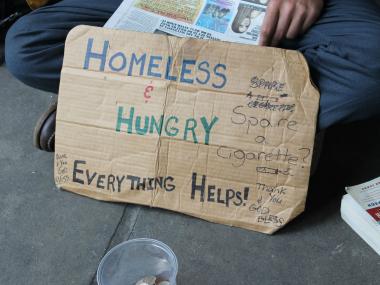NEW YORK CITY — The city has pumped hundreds of millions of dollars into dealing with the homelessness crisis, but despite some successes is still struggling with the volume of people entering the system, according to figures released in the Mayor's Management Report.
The number of people housed in city shelters is already at record-breaking levels and is climbing toward 60,000 individuals.
Department of Homeless Services figures show the that there were 59,734 individuals in shelter on Monday. That's 666 more people than the previous high of 59,068 people reported in December 2014.
Other indicators from the management report include:
►The numbers of people requesting one time emergency grants to prevent evictions jumped 26 percent to 82,306 from 65,138.
►The number of single adults who did not enter the shelter system after receiving preventative services dropped to 90.3 percent in fiscal year 2016 from 93.5 percent the year before.
►The number of households with children entering the shelter system increased 5 percent to 13,311 from 12,671. The number of adult family households without children jumped 6.6 percent to 1,476 from 1,385.
►Single adults returning to the shelter system after at least a year increased 6 percent to 19,139 from 18,091. And the daily average of single adults in the shelters jumped 12.6 percent to 12,757 individuals.
►The average length of shelter stays increased by approximately a month for single adults and adult families.
►The percentage of people diverted from the shelter system upon first contact decreased to 12.6 percent from 16.3 percent the year before.
►The daily cost of shelter for single adults increased by 20 percent to $94.57 from $78.80. The daily cost jumped 7 percent for family shelters to $120.22 from $105.37.
"We can still see that there is a housing crisis ongoing in New York City and some of those numbers are a reflection of the severe need for affordable housing," said Giselle Routhier, policy director for the Coalition for the Homeless.
In spite of these numbers, city officials say the effort to prevent homelessness has had a number of successes.
The percentage of people who returned to the shelter within a year of being placed in permanent housing dropped 6.5 percent for families with children and 5.5 percent for adult families.
City officials say the increase in emergency rental assistance applications does not have a direct correlation to the increase in people in shelters because individuals also enter the system due to other factors such as overcrowded apartments.
Last year, the percentage of people who received emergency rental assistance increased 2.3 percent, which city officials and advocates say is good.
"Anytime you can prevent homelessness with an arrears grant it is far cheaper than a homeless shelter," said Routhier.
And the increase in shelter spending is linked to increased security costs after multiple murders at city shelters this year.
"No one likes to see increased spending on shelters and for the homeless numbers to continue to rise," said Catherine Trapani, executive director of Homeless Services United. "But if there are more homeless people we have to adequately fund shelters so they have a safe place to stay because the city has a legal obligation to provide shelter to those in need."
And, if the city had not taken dramatic steps to deal with homelessness, officials predicted that there would be 66,000 people currently in shelter and 71,000 by the end of fiscal year 2017.
“The shelter population more than doubled in the two decades before this administration took over. This mayor’s work has helped to dramatically slow the pace of growth, and we will continue to implement new, aggressive citywide solutions to this citywide problem," said Lauren Gray, spokeswoman for the Department of Homeless Services.
In order to reduce the number of people in shelter the city must focus on increasing the amount of available affordable housing for people most at risk of becoming homeless, say advocates.
Those are households that earn 30 percent of area median income or about about $23,000 per year for a family of three, said Trapani.
► READ MORE: What is AMI?
"They are the least able to compete in New York City's overheated real estate market," Trapani said.
Advocates had called for Mayor Bill de Blasio's rezoning plans to include an option for developers to make 30 percent of their project affordable to people making 30 percent AMI, but the administration declined, instead agreeing to study ways to provide deeper affordability on some projects.
Trapani said she is hopeful that more can be done as projects start rolling out.
Routhier said the city has made progress in giving homeless families priority to affordable options such as Section 8 and NYCHA housing.
The average length of stay for families with children is 431 days, just one day above last year. But too many non-priority families are still receiving those services before homeless families.
"We can better allocate existing affordable housing resources to those with priority," said Routhier. "From our perspective, housing is the solution to homelessness."




















